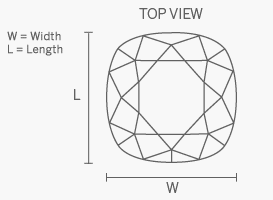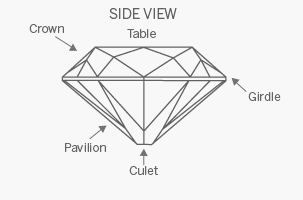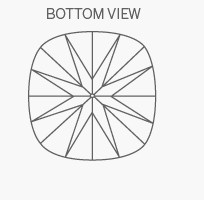Cushion Cut Diamonds Shape
The Essential 7C's
Every diamond has its own story, and every lady her own style.
At this point it should be noted that the shape of a diamond can also be referred to as its “cut”, like a round or princess cut. However, this should not be confused with the more commonly used term of diamond cut, which describes how well the diamond has been polished from the raw material (see section on diamond cut).
At Seventy Seven Diamonds we cater to the detailed wishes of every customer and want to ensure that they are well-informed about every diamond shape available. Our selection of beautiful shapes is accompanied by detailed information, images and recommendations on the uniqueness, the history and background, and the ideal ratio of every cut.
Cushion Cut Diamonds
1. The Basics | 2. Features | 3. Expert Advice | 4. History
1. The Basics
Also referred to as: PILLOW or CANDLELIGHT CUT

| Unique Features |
Facets |
L/W Ratio |
Origin |
Expert Tip |
| Larger facets, light dispersive. |
Usually 58 |
1.00-1.05 (square) >1.10 (rectangular) |
19th Century. |
Opt for modified brilliants with "crushed ice effect" if looking for more scintillation. |
2. Features



As its name suggests, a cushion cut is a square or rectangularshape with rounded corners that resemble a pillow. The cushion cut is usually comprised of 58 facets with a typical ratio of 1.00 to 1.05 for square shapes and 1.10 or greater for more rectangular ones. Although not as brilliant as round brilliants, cushion cuts have large facets allowing for a greater separation of white light into spectral colours.
The cushion cut may be described as a cross between the old mine cut and modern oval shape. As techniques and cutting styles have evolved over the years, several variations of the cushion cut have been developed, such as the Cushion Modified Brilliant* which may have an extra row of facets on the pavilion that alter the look of the diamond.
These modified brilliants often have what is called the "sparkling water" or "crushed ice" effect, giving them greater scintillation. Other subtle alterations have also been introduced, such as adding symmetrical kite- or half-moon-shaped facets to the pavilion and below the girdle.
3. Expert Advice
"Because of its extra facets, the Cushion cut can disperse more light through the stone which serves to hide inclusions more efficiently, making it one of the most brilliant of all square- and rectangular-shaped stones.
The Radiant cut diamond is also reknowned for hiding inclusions well.”
4. History & Background
The cushion, pillow or candlelight cut was developed in the 19th century and has undergone several transformations and developments since. The cushion cut has especially benefited from the invention of cleaving as this process has helped to maximise the shape’s light dispersion making it more dynamic and brilliant.

Where next?
To view cushion cut diamonds offered by Seventy Seven Diamonds, please click here.
To customise your cushion cut engagement ring, please click here.
If you would like to read more about diamond education, please click here.